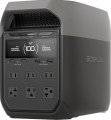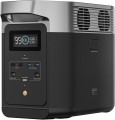Add to comparison |  |  |
|---|---|---|
| EcoFlow DELTA 3 | EcoFlow DELTA 2 | |
| Compare prices 3 | Compare prices 5 | |
| User reviews | ||
| TOP sellers | ||
2 USB A ports, 2 USB A Fast Charge ports, 2 USB C ports. Car cigarette lighter port DC5521. Jumps up to 2700 W are allowed. X-Stream port for fast charging (2200 W). LFP (LiFePO4) – lithium iron phosphate battery. | ||
| In box | charging station | charging station |
| Rated power | 1800 W | 1800 W |
| Peak power | 3600 W | 2700 W |
| Output waveform | sinusoid (PSW) | sinusoid (PSW) |
| UPS function | ||
Outputs | ||
| Sockets (230 V) | 4 | 4 |
| USB A | 2 5В/2.4А 12 W | |
| USB A (quick charge) | 2 5В/2.4A, 9В/2A, 12В/1.5A 18 W | 2 5В/2.4A, 9В/2A, 12В/1.5A 18 W |
| USB C | 2 3 A, 5 A 100 W | 2 5 A 100 W |
| Car cigarette lighter | ||
Inputs (station charging) | ||
| From solar panels | ||
| Input port XT60 | ||
| Add. ports | Extra Battery Port | |
Battery and charging time | ||
| Connecting an additional battery | ||
| Battery type | LiFePO4 | LiFePO4 |
| Battery capacity | 1024 W*h | 1024 W*h |
| Charging cycles | 4000 | 3000 |
| Charging time (socket) ≈ | 60 min | 80 min |
| Charging time (solar panel) ≈ | 130 min | 180 min |
| Charging power (socket) | 1500 W | 1200 W |
| Charging power (solar panel) | 500 W | 500 W |
General | ||
| Smartphone synchronization | Bluetooth and WiFi | Bluetooth and WiFi |
| PSU | built into the body | built into the body |
| Display | ||
| Carrying handle | ||
| Operating temperature | 0 °C ~ +45 °C | 0 °C ~ +45 °C |
| Dimensions | 398x202x284 mm | 281x211x400 mm |
| Weight | 12.5 kg | 12 kg |
| Warranty | 5 years | 5 years |
| Added to E-Catalog | november 2024 | october 2022 |
Comparing the EcoFlow DELTA 3 and DELTA 2 charging stations, it can be noted that both models have a nominal power of 1800 W and support a sinusoidal output. However, DELTA 3 offers a higher peak power of 3600 W compared to DELTA 2's 2700 W, making it more suitable for high-power devices. The charging time from the grid for DELTA 3 is about 60 minutes, while DELTA 2 requires about 80 minutes. Both stations have the same battery capacity of 20 Ah and use lithium iron phosphate batteries, but DELTA 3 has a longer lifespan with 4000 charging cycles versus 3000 for DELTA 2. In terms of outputs, DELTA 3 offers 2 USB A ports, while DELTA 2 has 4 USB A ports, including fast-charging ports. Users note that DELTA 3 is more convenient to use due to the placement of outputs in the front, whereas DELTA 2's are located at the back. Both models have similar dimensions and weight, but DELTA 3 is slightly heavier. Overall, DELTA 3 appears more advanced and powerful, while DELTA 2 might offer more charging ports.